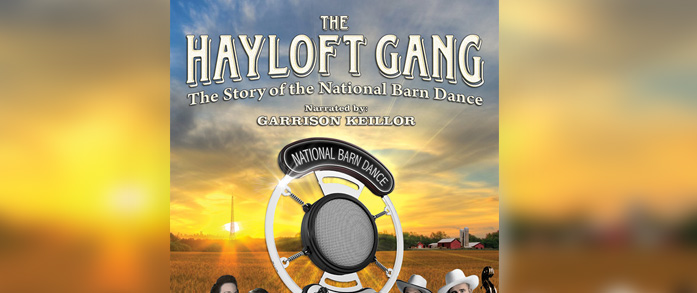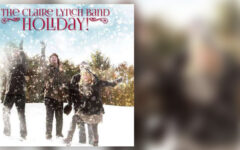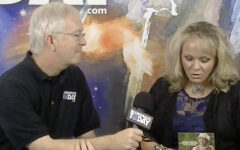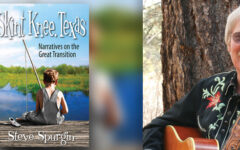
This terrific documentary aired on PBS in 2011. Producer Stephen Parrys Hayloft Gang Productions now offers it for sale at www.hayloftgang.com. It includes never-before-seen footage of pre-WWII country music. Although Chicago’s WLS National Barn Dance isn’t known for bluegrass, it is interwoven with bluegrass history.
Garrison Keillor narrates.
The first section deals with the 1920s birth of popular hillbilly music and broadcast radio. In an amazingly short time, the two industries intertwine through Sears & Roebuck’s marketing of their WLS radio National Barn Dance and Silvertone radios.
Stressing the FAMILY experience around the radio, WLS wanted a music program that “sounded like home.” The program used nostalgia even in 1924, reminding folks of “our farm communities of yesteryear.”
In 1928 Sears sold the successful station to Prairie Farmer magazine. In 1930 the signal was boosted to 50,000 watt clear channel status. The show prided itself that millions were listening TOGETHER over four hours each Saturday night. The cast became familiar friends nicknamed the Hayloft Gang.
Nashville’s WSM Barn Dance/Grand Ole Opry is the most familiar imitator – there were many. Judge George D. Hay was stolen away from the National Barn Dance by WSM in 1925, expressly to mimic WLS’ success.
The middle portion of this program highlights many star personalities in the National Barn Dance’s Hayloft Gang, including:
- Bradley Kincaid — although classically trained, Kincaid focused on “mountain purity.” He introduced folk music to millions, selling 200,000 song books in 1930.
- TV comedian George Gobel — “Little Georgie Gobel” was the Hayloft Gang’s youngest cowboy singer at age 14.
- Gene Autry was the monster star to come out of the Hayloft Gang, starting in 1931.
- The Kentucky Ramblers — of Davenport Iowa’s WOC radio. WLS stole the group (a common practice) and renamed them The Prairie Ramblers (Prairie Farmer magazine, remember?). They featured the exact instrumentation (including hot mandolin) and “stomp music” that Bill Monroe used later with his early Blue Grass Boys. Monroe credited the Ramblers as making an impression on him. (The three Monroe brothers of course danced in the National Barn Dance road show.)
- John Lair — recruited rural musicians from Kentucky, including Karl & Harty, an early brother duet influence (although they weren’t brothers). Lair’s instrument was the typewriter – generating romanticized marketing material about country life and music. Lair later founded Cincinnati’s WLW Renfro Valley show.
- Linda Parker — reformed juvenile delinquent saloon singer from industrial Hammond, Indiana, made famous as the Little Sunbonnet Girl with her mountain dulcimer. Her untimely death (from appendicitis) was nearly a national disaster. Lair marketed her death story aggressively.
- Pat Buttram — hayseed comedian. Later he played Gene Autry’s sidekick, and Mr. Haney on the TV show Green Acres.
- Patsy Montana – Ruby Blevins came in from the farm for an audition announced over WLS. As Patsy Montana, by 1934 she wrote and sang I Want to Be a Cowboy’s Sweetheart (using a polka beat to appeal in Wisconsin) — the first female million-selling record. She’s in the Country Music Hall of Fame.
- Lulu Belle and Scotty Wiseman – these Kentuckians met and married on the National Barn Dance. Lulu Belle won a 1936 nationwide poll as favorite female star, beating Hollywood movie queens… since John Lair heavily promoted her pregnancy and the birth of Linda Lou (neatly named for the dear departed Linda Parker). Bluegrassers will like Scotty playing his Gibson Mastertone in a clear, precise, if old-fashioned 3-finger roll. It harkens back to Charlie Poole rather than anticipates Earl Scruggs, but there’s no question it’s 3-finger.
- The DeZuriks — “the Cackle Sisters,” with clucking and barnyard noises incorporated into their fine duet harmony and yodeling.
As the program concludes, WWII pulls millions off the farm for factory production, and nostalgia for rural life wanes. Although the Grand Ole Opry modernized with honky tonk juke box music, the National Barn Dance felt it unwholesome, and refocused on patriotic production numbers broadcasting over Armed Forces Radio.
TV and rock ‘n’ roll doomed the National Barn Dance, which modernized the Hayloft Gang with fresh acts including Homer & Jethro. But Prairie Farmer wanted out, and by 1960 the station format changed to rock ‘n’ roll records. Thirty-six years of music that was described as “like going to Grandma’s” was over.
Besides the excellent original recordings, air checks and movie sound tracks, incidental acoustic music is provided by Chris Walz, Colby Maddox, and Paul Tyler of Chicago’s Old Town School of Folk Music.
This DVD is an engaging 60 minutes of history, music and images. I enjoyed it immensely.
Go to www.hayloftgang.com to get a copy.







